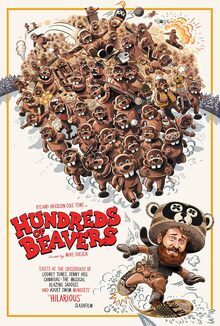Hundreds of Beavers

“Hundreds of Beavers,” a boldly bizarre, nearly wordless slapstick comedy about a 19th-century trapper doing battle with nature, exceeds expectations in every way, including the promise of its title. By my count there are thousands of beavers in this movie. Thousands! And oh, my goodness, they are nasty buggers. The BADL (Beaver Anti-Defamation League) will be out in force once they get word of this motion picture, which depicts an army of beavers building a dam into a bad guy lair to rival the volcano fortress in “You Only Live Twice” and the title structure of “Indiana Jones and The Temple of Doom.”
The hero, trapper Jean Kayak (played by Ryland Brickson Cole Tews – I can’t wait to see that name wrapping around a marquee), doesn’t get in there until the final section of the movie. Until that point, Jean’s got his hands full trying to survive in an icy mountain forest that looks as if somebody reimagined “The Revenant” as a black-and-white cartoon starring Popeye the Sailor Man. During regular visits with a merchant (Doug Mancheski) where Jean exchanges pelts for tools, the trapper falls for the man’s daughter (Olivia Graves), who acts demure but is quite randy. The price of marrying her is (ta-dum!) hundreds of beaver pelts. So there’s a love story, too, kinda like in the videogame “Donkey Kong”.
The film’s writer, director, editor, and main visual effects artist Mike Cheslik has taken a page from other filmmakers who lean into budgetary constraints rather than fight them. “This is a punk lo-fi look,” he said in an interview with No Film School. “This is our style, man.” The non-human mammals featured in this movie—beavers and horses and raccoons and skunks and such—are human performers in mascot suits with zippers up the back. They have big round Disney-animal eyes and and walk on their hind legs (or march or trudge or stroll or skip). There were likely no more than a dozen of the “creatures” on set at any given time—according to Cheslik and producer Kurt Ravenwood, the entire budget of the film was $150,000, not including deferred labor costs—so what you’re looking at is one of the best inadvertent advertisements for the idea that you can create entire worlds on the cheap if you have a strong vision and turn what are usually thought of as liabilities into strengths.
The result is reminiscent of a mindset demonstrated, to wildly different ends, in David Lynch’s “Eraserhead,” Robert Rodriguez’s “El Mariachi,” and the parts of Wes Anderson movies where he shows you, let’s say, the Grand Budapest Hotel, and it’s obviously a miniature building on a miniature mountain, and not only is the movie not pretending it’s a real structure, the storybook-ness of the image is the point. Figurative, metaphorical or just plain sketchy images made with love and presented with pride have a totemic power that overcomes petty concerns about “production values” and plugs into the pleasure centers of the brain. This truth eludes far too many low-budget filmmakers who try for a “Hollywood look” and sadly achieve the cinema equivalent of a five-year old trying to dunk a basketball. “Hundreds of Beavers” understands this on a deep level.
In that spirit, many of the movements of people and animals in the movie are no more “realistic” than those of the little cutout-looking characters on “South Park.” And that’s what makes them funny. Jean shimmies up and down very tall trees, inchworm-style. Sometimes he’s nude when he does it. (Don’t worry, parents; the naughty bits are hidden by the bark he’s scraping against.) There’s a horse that’s blatantly just two performers sharing a “horse costume” that’s barely a costume. You can tell a character or creature has died because their eyes become huge X’s. It’s like in “Monty Python and the Holy Grail” where they couldn’t afford real horses so the actors just skipped around the English countryside banging coconut halves together to suggest “hoofbeats.”
Cheslik hails from the “if it makes me laugh, I’ll do it” school of comedy filmmaking. The opening section, a musical montage, has just one non-animated character, Jean, whose applejack addiction destroys his life; the rest are drawn in the manner of underground “comix,” seemingly with fat-tipped markers. Period-specific facts and customs collide, Mel Brooks-style, with modernity. The merchant’s daughter tantalizes Jean with a half-inch glimpse of forbidden ankle, then escalates to a pole dance. The beavers occasionally wear clothes, including hardhats and reflective vests. One is seen carrying a clipboard. They appear to have invented electricity, the assembly line, and video surveillance.
Cheslik has cited older forms of movie slapstick as influences, from the silent work of Charlie Chaplin and Buster Keaton to the sound-era comedy of The Three Stooges and Stan Laurel and Oliver Hardy (referenced here in the form of two “detective” beavers investigating the string of beaver “murders” committed by Jean; they’re dressed to suggest Sherlock Holmes and Dr. Watson played by Laurel & Hardy played by beavers). Tews, a high school friend of Cheslik and a filmmaker himself, is a physical comedian of rare precision, giving a performance as vivid and fearless as the best of Jim Carrey and Bruce Campbell. The poster is modeled after one of the posters for the 1963 slapstick epic “It’s a Mad, Mad, Mad, Mad World.”
Real-world laws of physics rarely apply. Jean is shot through the air like a rocket and survives falling hundreds of feet from trees or being crushed by giant objects and pops back up to have another go. When famished characters stare at a potential food source, there’s a brief dissolve and you see that they are imagining a man-sized turkey drumstick or slice of pepperoni pizza.




